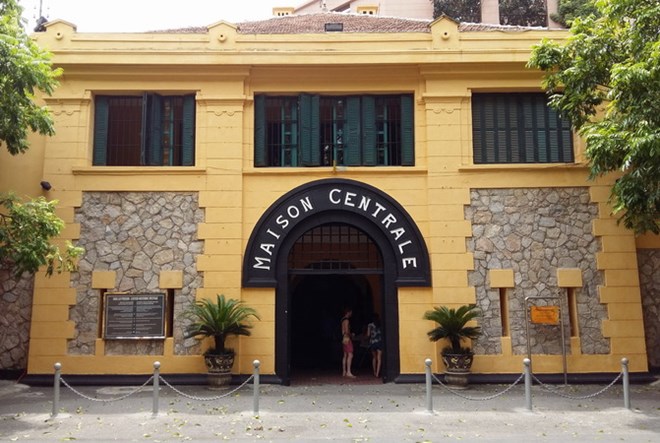Top experience you may interested in:
Hoa Lo Prison – A Historical Landmark in Hanoi: Address, Opening Hours, and Latest Ticket Prices 2023
Hoa Lo Prison, also known as “Ngục Hỏa Lò,” was constructed by French colonizers to imprison and torture Vietnamese soldiers and patriotic leaders. Converted into a preserved site, the prison has become a unique tourist destination in the capital. This article provides essential information and insights into the historical significance of this place and the experiences it offers to visitors.
Location and Directions to Hoa Lo prision:
Address: No. 1, Kp. Hỏa Lò, Hoàn Kiếm District, Hanoi. Ngục Hỏa Lò is situated in Hỏa Lò Street, centrally located in Hoàn Kiếm District, and close to many other famous tourist spots. Visitors can access the prison by various means of transportation, including private and public options.
From Hoan Kiem Lake area, follow Lê Thái Tổ Street towards Hàng Trống and continue straight to Bà Triệu Street. Then, turn right onto Hai Bà Trưng Street, walk approximately 500m, and turn left onto Hỏa Lò Street. The prison is located at No. 1 on this street.
For those seeking cost-effective transportation, buses are the top choice. Buses numbered 32, 02, 38, and 41 have stops near Hoa Lo Prison, making commuting convenient.
 Operating Hours and Ticket Prices of Hoa Lo prision
Operating Hours and Ticket Prices of Hoa Lo prision
Hoa Lo Prison opens daily from 8:00 AM to 5:00 PM, including holidays and festivals.
The ticket price for visiting Hoa Lo Prison is 30,000 VND per person. Some individuals are eligible for free admission or discounted tickets, as follows:
Eligible for free admission:
- Children under 15 years old.
- Severely disabled individuals in specific categories.
- Members of veteran associations, national prison liaison committees, and anti-French resistance liaison committees.
- Individuals with revolutionary merits.
Eligible for 50% ticket discount:
- Students (show student ID when purchasing tickets).
- Severely disabled individuals.
- Vietnamese citizens aged 60 and above.
- Individuals eligible for social policy.
In addition, audio guide services are available at the prison for 50,000 VND per headphone.
What to Know About Hoa Lo Prison:
Historical Background:
In response to Vietnamese people’s resistance movements in the late 19th century, French colonizers strengthened their oppressive machinery, including the reinforcement of police forces, an improved court system, and the construction of prison networks. In 1896, on the land of Phu Khanh Village, Vĩnh Xương, H. Thọ Xương, Hanoi, the French built Hoa Lo Prison, one of the largest prisons during their colonial rule in Indochina.
Previously, Hoa Lo was known for its traditional pottery craft. However, the French turned it into a place of confinement, suffering, and deprivation of freedom for thousands of Vietnamese soldiers and revolutionaries.
Despite the harsh conditions, the incarcerated revolutionaries remained resolute, maintaining their revolutionary spirit. They transformed Hoa Lo Prison into a school where they propagated revolutionary theories, and some managed to escape and return to the people to continue contributing to the national liberation movement.
Prominent leaders, such as Phan Bội Châu, Nguyễn Quyền, Nguyễn Lương Bằng, Lương Văn Can, Hồ Tùng Mậu, and five General Secretaries of the Communist Party of Vietnam (Nguyễn Văn Cừ, Lê Duẩn, Trường Chinh, Đỗ Mười, and Nguyễn Văn Linh), were imprisoned at Hoa Lo.
After North Vietnam’s independence, the Vietnamese government temporarily used Hoa Lo Prison to detain law offenders. However, from August 5, 1964, to March 31, 1973, the prison was used to house American pilots shot down during bombing missions in North Vietnam.
In 1993, the Vietnamese government decided to convert Hoa Lo Prison into a historical site to meet the capital’s economic development needs. A part of the prison’s southeast area was preserved, renovated, and transformed into a historical monument of Hanoi. It now houses a memorial dedicated to the brave revolutionaries who sacrificed for national independence and freedom.
The Enormous Guillotine – A Horrifying Symbol:
- Inside Hoa Lo Prison, there was a guillotine, a human-killing instrument invented by French doctor Guilotane, claimed to be a humane way of execution, replacing medieval torture methods like breaking on the wheel or impalement.
- The guillotine consisted of a wooden platform on which the prisoner laid, with the head positioned beneath the descending blade. Above the platform was a nearly 4-meter-high iron frame, and the blade was made of steel with a slanted edge. When the guillotine was triggered, the blade dropped from above with a force equivalent to 60kg. The prisoner’s head fell into a basket below, while the body was caught in a wicker basket.
The “Friendship” Banyan Tree – A Historical Witness:
According to accounts of former political prisoners, the origin of the banyan tree dates back to before 1930 when prisoners sentenced to forced labor by the court gathered wild banyan saplings and planted them in the prison yard. Over time, the banyan trees grew and became closely associated with generations of political prisoners.
Whenever allowed outside, political prisoners would gather around the banyan tree to enjoy fresh air and discuss strategies against the colonial regime.
The banyan tree witnessed the everyday life, aspirations, ideals, and emotions of the communists. It also served as an important “secret mailbox” for exchanging information and revolutionary materials among the prisoners.
The Dungeon (Solitary Confinement) – Hell within Hell:
The dungeon was a section of the prison where solitary confinement cells measuring a mere 4m2 with dark, black-painted walls were located. The dungeon lacked light and fresh air, creating an overwhelmingly oppressive atmosphere for the prisoners.
The sleeping place for prisoners was made of specially designed concrete that inclined low, causing blood to rush to their heads. The dungeon was used to punish those who organized struggles, propagated the revolution, or attempted to escape. Comrade Trường Chinh was also held in solitary confinement here when he organized a rally in prison to commemorate International Labor Day.
Top attraction to visit in Ha Noi




